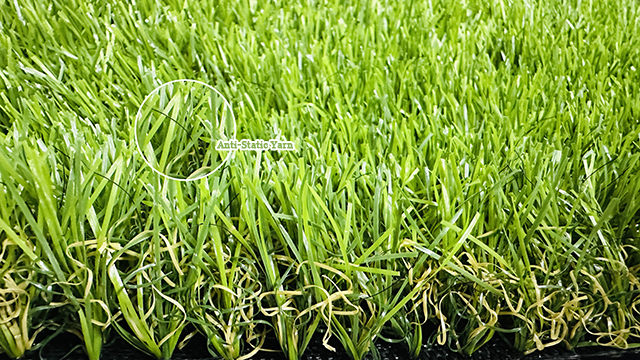
The Revolutionary Innovation-New synthetic artificial grass with Anti-Static Yarn and PU Backing
In recent years, synthetic artificial grass has been widely adopted in sports fields, landscaping, and commercial spaces. With technological advancements, modern synthetic grass has not only improved in appearance and durability but also addressed many pain points of traditional synthetic artificial grass through innovations like anti-static yarn and polyurethane (PU) backing. This article explores the working principles of anti-static yarn, the advantages of PU backing, and the applications of this next-generation synthetic turf.
1. Anti-Static Yarn: Mechanism and Benefits
1.1 The Problem of Static Electricity
In traditional synthetic artificial grass, friction (from running athletes, rolling balls, or wind) can cause electrostatic buildup.
Discomfort: Users may experience minor electric shocks.
Dust Accumulation: Static attracts dust and airborne particles, affecting cleanliness and aesthetics.
Equipment Interference: In sensitive electronic environments, static can disrupt device performance.
1.2 How Anti-Static Yarn Works
Anti-static yarn mitigates electrostatic buildup through:
Conductive Fibers: Embedded materials like carbon fiber or metal-coated threads help dissipate static charges.
Anti-Static Coatings: Special treatments reduce surface resistance, preventing charge accumulation.
Humidity Regulation: Some yarns absorb minimal moisture to maintain surface conductivity.
1.3 Advantages of Anti-Static Synthetic Artificial Grass
Enhanced Comfort: Reduces static shocks for athletes and users.
Easier Maintenance: Minimizes dust adhesion, lowering cleaning efforts.
Longer Lifespan: Less fiber wear due to reduced electrostatic repulsion.
2. Benefits of PU Backing (Polyurethane Backing)
While traditional synthetic grass often uses latex backing, PU backing offers superior performance:
2.1 Greater Durability
Tear Resistance: More flexible and resilient against heavy impacts and stretching.
Weather Resistance: Performs well in extreme temperatures, suitable for diverse climates.
2.2 Improved Drainage
Porous Structure: Optimized drainage design prevents waterlogging, ideal for all-weather sports fields.
Anti-Microbial: PU backing supports mold and bacterial growth, to ensure hygiene.
2.3 Eco-Friendliness & Sustainability
Recyclable: Some PU backings use eco-friendly materials, aligning with sustainability trends.
Low VOC Emissions: Compared to latex, PU emits fewer volatile organic compounds (VOCs), promoting healthier environments.
![synthetic artificial grass for Commercial lawn]()
3. Applications
3.1 Sports Facilities
Soccer & Football Fields: Anti-static yarn enhances player comfort, while PU backing improves durability.
Tennis & Golf Practice Areas: Reduces dust attraction, maintaining clean playing surfaces.
3.2 Commercial & Landscaping
Rooftop Gardens & Balconies: Lightweight and weather-resistant PU backing suits architectural greening.
Exhibition Halls & Playgrounds: Anti-static properties enhance safety and cleanliness.
3.3 Industrial & Specialized Uses
Electronics Manufacturing Sites: Minimizes static interference with sensitive equipment.
Airports & Military Training Grounds: High-strength PU backing withstands heavy-duty use.
4. Future Trends
With the innovation and development of materials science research, synthetic artificial grass is constantly innovating:
Smart Turf: Integrated sensors to monitor static, moisture, and wear.
Greener Materials: Bio-based PU and biodegradable fibers could become standard.
Multifunctional Designs: Combining cooling coatings, antimicrobial tech, and more for enhanced performance.
The new generation of synthetic artificial grass, featuring anti-static yarn and PU backing, solves traditional static issues while significantly improving durability, drainage, and sustainability. Whether for sports, landscaping, or industrial use, this innovation delivers a safer, longer-lasting, and low-maintenance solution. As technology progresses, synthetic grass will continue to expand its applications.
Considering an upgrade to your synthetic grass system? Anti-static + PU-backed synthetic artificial grass could be the ultimate choice!













